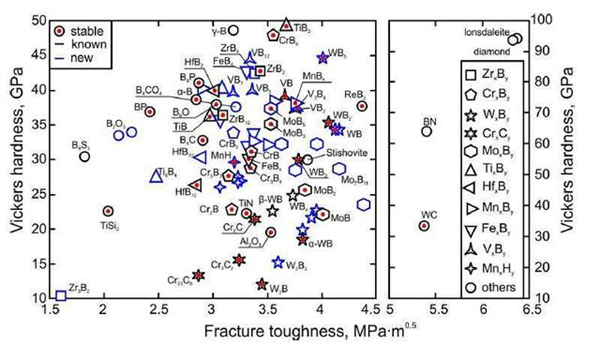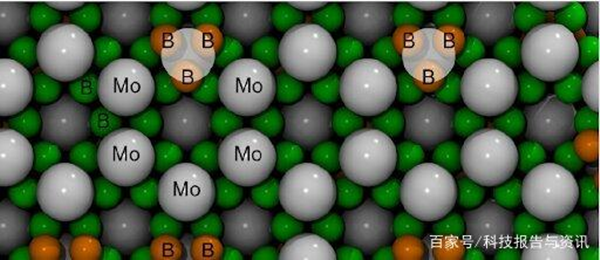In the search for new superhard compounds, researchers predicted the stable molybdenum borate and its crystal structure. They found that the highest boride contains four to five boron atoms per molybdenum atom. The estimated Vickers hardness of MoB5 is 37 to 39 GPa, which makes it a potential superhard material. The study was published in The Journal of Physical Chemistry Letters.
Previously, a group of researchers led by Professor Artem Oganov of the Moscow Institute of Physics and Technology (MIPT) published a study in the Journal of Applied Physics, which comprehensively sorted out the list of superhard materials with potential industrial applications. This list is made by using the new model of evolutionary algorithm USPEX, Vickers hardness (the pressure required to leave a pyramid indentation in the material) and fracture toughness (the ability of the material to resist fracture transmission), and is called "treasure map" for the use of the author.
In this new paper, scientists from Skoltech University in Moscow, the Moscow Institute of Physics and Technology, the RAS Institute of General Physics in AM Prokhorov, the Pirogov Russian National Medical University and the Northwestern Polytechnical University of China studied the molybdenum boroide region on the map. Transition metal borides are potential substitutes for traditional cemented carbide and superhard materials in technical applications. Unlike the widely used diamond and cubic boron nitride, the synthesis of transition metal borides does not require high pressure, so the production cost is low.

Due to the mutual repulsion of electrons, the high valence electron density of metal atoms can resist compression, while the covalent boron-boron and boron-metal bonds can resist elastic and plastic deformation.
"The simulated X-ray diffraction (XRD) The figure is compared with the experimental figure to determine whether the predicted structure is compatible with the experimental structure. However, considering the transition metal borides, such as molybdenum borate, the XRD diagram can only show the signals from the heavier atoms, while the position of the lighter boron atoms is basically invisible, which is why the crystal structure model based only on experimental data is usually unrealistic and unstable. Therefore, a comprehensive method to determine the crystal structure needs the most advanced theoretical calculation method. " Alexander Kvashnin, senior researcher of Skoltech and MIPT, said.
It is found that MoB5 is the stable highest boride, but the simulated X-ray diffraction pattern is close to but not identical with the experimental data. The predicted pentaboride has some weak peaks not observed in the experiment. This implies a high symmetry in the experimental sample. The key structural element of this new compound is the triangular arrangement of boron atoms, molybdenum layers and boron atoms in the graphene sample layer. Boron and molybdenum atoms are arranged alternately, and some Mo atoms are replaced by B3 triangles uniformly distributed throughout the crystal volume.
"We put forward a hypothesis that the structure of the highest boride is disordered, and the boron triangle statistically replaces the molybdenum atom. To prove this, we developed a lattice model that allows us to define the rules that control how the boron unit should be positioned on it." said Dmitry Rybkovskiy, a researcher at Skoltech and AM Prokhorov Institute of General Physics, the first author of the paper.
Through the brute force search of the position of molybdenum atom and boron triangle, and the sampling of different variants, patterns related to stability were found. Each metal atom in the stable phase contains 4-5 boron atoms. MoB4.7 is the most stable of these compounds, and has the best matching with the experimental X-ray diffraction pattern.
"This study is an interesting example of the interaction between theory and experiment. The theory predicts a compound with strange characteristics and new structure, but the experiment shows that the actual material is more complex and its structure is partially disordered. The theory we developed based on these findings enables us to reproduce all experimental observations, understand the exact composition and structure of this material, and its detailed characteristics. In particular The calculated hardness is close to the range of superhard materials. "Said Artem Oganov, professor of Skoltech and MIPT and head of the research team.
Superhard materials have a wide range of industrial applications, such as machine tool manufacturing, jewelry or mining. They are used for cutting, polishing, grinding and drilling, so finding new superhard compounds is an important task.
Technological innovation
Honesty is the foundation
Contact Number: +86-15698999555 |
Address: NO.6 ,SHENGHUA STREET,TAIHE DISTRICT, JINZHOU CITY, LIAONING PROVINCE, CHINA. |